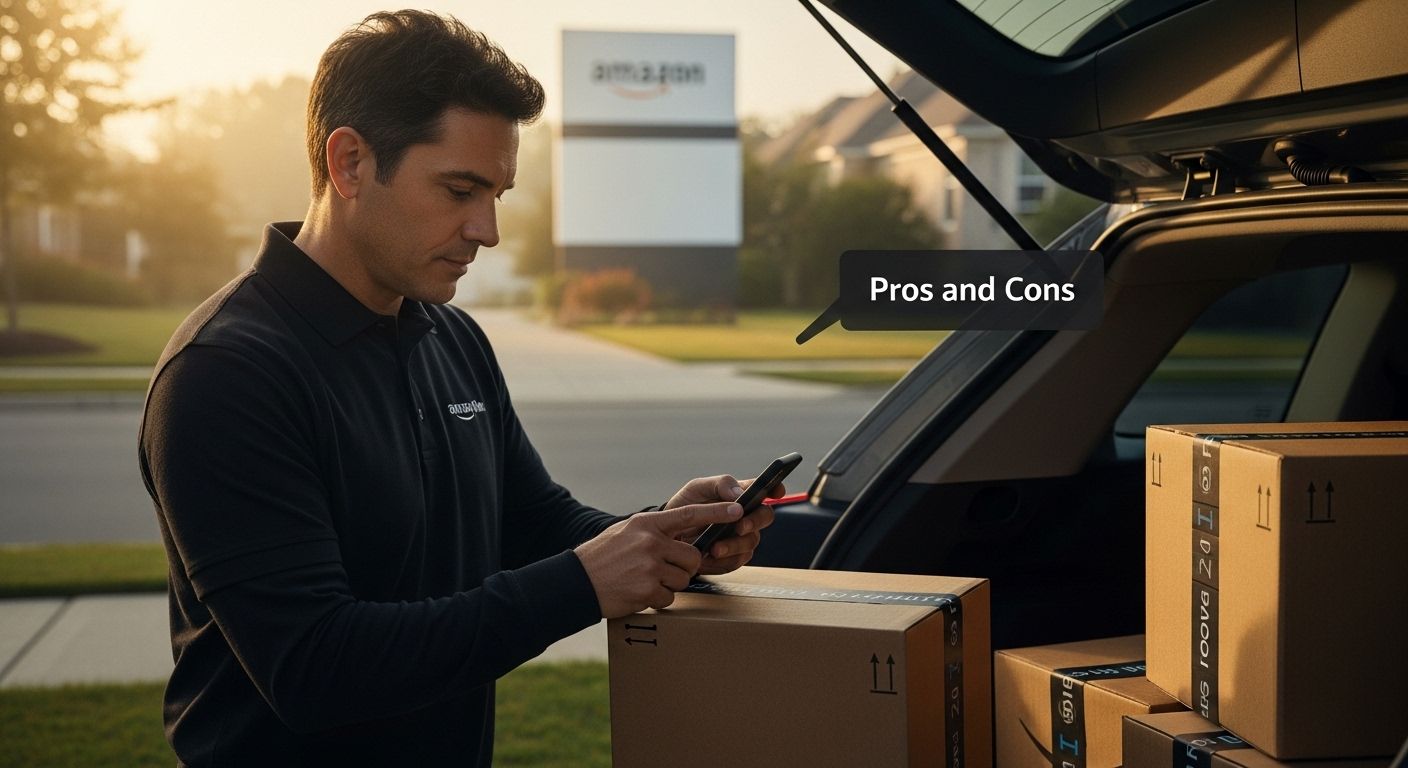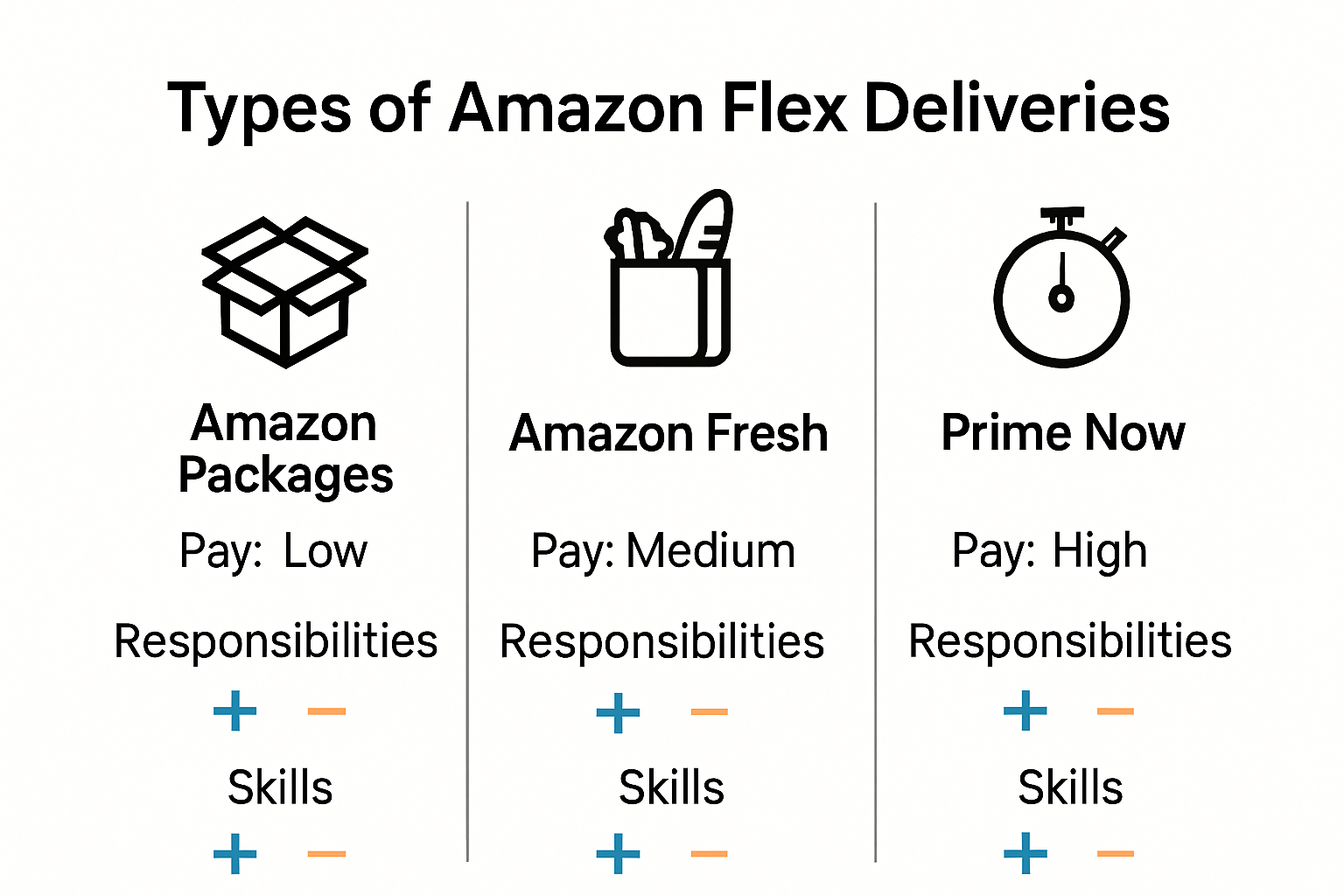Pros and Cons of Amazon Flex: What Drivers Need to Know 2025

Amazon Flex is reshaping gig work for thousands of drivers, offering the chance to pick your own schedule and hit the road when it suits you. That might sound like pure freedom. But the reality is more complicated. Nearly every driver must cover all their own expenses, from gas to maintenance, which can eat up a big chunk of those advertised $18 to $25 hourly earnings. So while you might expect easy cash on your terms, there are hidden hurdles every Flex driver needs to know about.
Quick Summary
| Takeaway | Explanation |
|---|---|
| Amazon Flex offers flexible scheduling options | Drivers can choose their delivery blocks according to their personal availability, making it suitable for various lifestyles. |
| Earnings typically range from $18 to $25 per hour | Drivers can achieve competitive hourly rates by strategically managing time and block selection. |
| Drivers must cover their own expenses | As independent contractors, drivers need to pay for fuel, vehicle maintenance, and taxes, which can impact net earnings. |
| Maintaining efficiency is crucial for success | Successful drivers optimize routes and package management to increase delivery performance and earnings potential. |
| Be aware of operational pressures and performance metrics | High expectations for delivery efficiency and customer satisfaction can create stress and affect job security. |
How Amazon Flex Works for Drivers
Amazon Flex offers a unique opportunity for independent drivers to earn money by delivering packages for Amazon. The platform operates as a gig economy service that connects drivers with delivery opportunities through a mobile application.
The Basics of Amazon Flex Delivery
Drivers use their personal vehicles to complete delivery blocks, which are scheduled time slots for picking up and delivering packages. When you sign up as an Amazon Flex driver, you gain access to a digital platform that allows you to view available delivery blocks in your local area. These blocks typically range from 1 to 4 hours, giving drivers flexibility in choosing their work schedule.
The process begins with selecting an available block through the Amazon Flex app. Once confirmed, drivers proceed to an Amazon warehouse or delivery station to pick up their assigned packages. The app provides detailed instructions about package pickup, delivery routes, and specific delivery requirements.
Earning Potential and Payment Structure
Amazon Flex drivers are compensated based on the duration of their delivery blocks. Rates can vary depending on location, time of day, and delivery type. Most drivers earn between $18 to $25 per hour, though this can fluctuate based on various factors. Payments are processed weekly, typically through direct deposit, providing a consistent income stream for drivers.
Amazon Flex Delivery Types
Amazon Packages
Standard delivery of packages to residential and business addresses
Amazon Fresh
Grocery delivery services requiring additional care and temperature management
Prime Now
Rapid delivery of items within a short time window

Technology and Driver Support
The Amazon Flex mobile application is the central hub for drivers. It provides real-time information about available blocks, navigation assistance, package tracking, and earning summaries. Drivers can track their performance, view detailed earnings reports, and manage their delivery schedule entirely through the app.
While the platform offers significant flexibility, it also requires drivers to meet specific requirements. These include having a valid driver's license, a smartphone, a reliable vehicle, and passing a background check. Drivers are considered independent contractors, which means they are responsible for their own expenses such as fuel, vehicle maintenance, and taxes.
Top Pros of Amazon Flex in 2025
Amazon Flex continues to offer compelling advantages for independent drivers seeking flexible earning opportunities in the evolving gig economy landscape.
Quick Comparison: Pros vs Cons
| Pros | Cons |
|---|---|
| Flexible scheduling | Must pay all expenses (fuel, maintenance) |
| Competitive earning potential | No employment benefits (health, PTO) |
| Technology-driven support | Risk of sudden deactivation |
| Multiple delivery types available | High operational and performance pressure |
| Educational/financial perks | Physical and mental strain |
Unmatched Scheduling Flexibility
One of the most significant pros of Amazon Flex is the unprecedented level of schedule control it provides drivers. Unlike traditional employment models, Amazon Flex allows you to choose delivery blocks that fit your personal lifestyle and availability. Drivers can select from morning, afternoon, evening, and weekend blocks, making it an ideal option for students, part-time workers, or individuals seeking supplemental income.
The platform's digital interface enables real-time block selection, giving drivers instant access to available delivery opportunities. This means you can adjust your work schedule week by week, accommodating personal commitments, other jobs, or unexpected life events.
Competitive Earning Potential
Amazon Flex offers attractive earning potential for drivers willing to strategically manage their time and routes. Most drivers can consistently earn between $18 to $25 per hour, with opportunities to maximize income through strategic block selection and efficient delivery practices.
Ways to Enhance Earnings:
- • Selecting High-Demand Blocks: Identifying peak delivery times and locations with potentially higher pay rates
- • Maintaining Efficiency: Optimizing delivery routes and minimizing time spent between deliveries
- • Consistent Performance: Building a strong delivery record to access more lucrative block opportunities
Technology-Driven Support and Opportunities
The Amazon Flex platform distinguishes itself through sophisticated technological support for drivers. The mobile application provides comprehensive tools that streamline the delivery process, including real-time navigation, package tracking, transparent earnings reporting, and performance insights.
Main Cons and Challenges to Expect
While Amazon Flex offers attractive opportunities, potential drivers must carefully consider the significant challenges and drawbacks associated with the platform.
Financial Uncertainties
- • All vehicle expenses (fuel, maintenance, insurance)
- • No traditional employment benefits
- • Complex tax obligations
- • Income inconsistency
Operational Pressures
- • Unpredictable block availability
- • Strict delivery requirements
- • Technology dependence
- • Risk of sudden deactivation
Physical & Mental Strain
- • Extensive driving and package lifting
- • Tight delivery windows stress
- • Performance pressure
- • Potential burnout risk
One of the most critical challenges for Amazon Flex drivers is the complex financial landscape of independent contracting. Drivers are responsible for all vehicle-related expenses, including fuel, maintenance, insurance, and depreciation. These costs can significantly reduce overall earnings, often cutting into potential profits more than drivers initially anticipate.

Tips for Maximizing Earnings and Efficiency
Successful Amazon Flex drivers understand that strategic planning and smart techniques can significantly enhance their earning potential and operational efficiency.
Key Success Strategies
Strategic Block Selection
Understand peak delivery times, recognize high-demand locations, and schedule blocks during premium payment periods.
Route Optimization
Review delivery locations beforehand, group packages by proximity, and use advanced GPS tools.
Financial Management
Track all expenses meticulously, understand tax implications, and treat your work as a small business.
Vehicle Organization
Invest in storage solutions, maintain organized cargo space, and use temperature-controlled containers when needed.
Transform Your Amazon Flex Experience!
Tired of the stress and uncertainty of manual block grabbing? FlexoTap automates the entire process, capturing high-paying blocks 24/7 while you focus on what matters most.
Try FlexoTap NowFrequently Asked Questions
How does Amazon Flex work for drivers?
Amazon Flex allows independent drivers to earn money by delivering packages for Amazon using their own vehicles. Drivers select delivery blocks through the mobile app that specify the timeframes for pickups and deliveries, typically ranging from 1 to 4 hours.
What are the earnings potential and payment structure for Amazon Flex drivers?
Amazon Flex drivers can earn between $18 to $25 per hour, depending on factors like delivery type and location. Payments are processed weekly via direct deposit, and drivers must keep track of their own expenses, including fuel and maintenance costs, which can impact net earnings.
What are some of the main advantages of driving for Amazon Flex?
Key advantages include unmatched scheduling flexibility, competitive earning potential, and the use of technology-driven tools for support. Drivers can select delivery blocks that fit their schedules and access educational and financial perks.
What challenges do drivers face when working with Amazon Flex?
Drivers face several challenges, including financial uncertainties related to covering their own expenses, operational pressures to meet performance metrics, and potential physical and mental strain from the demands of the job.
